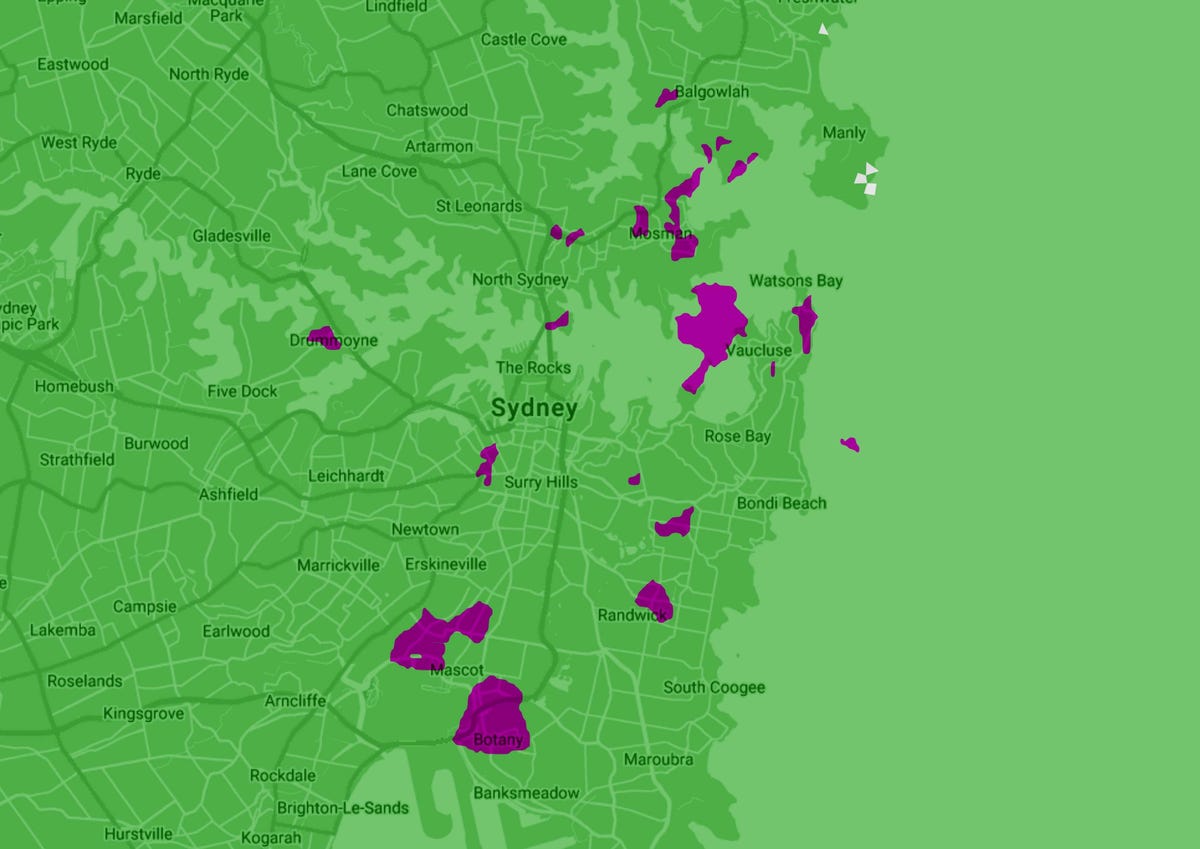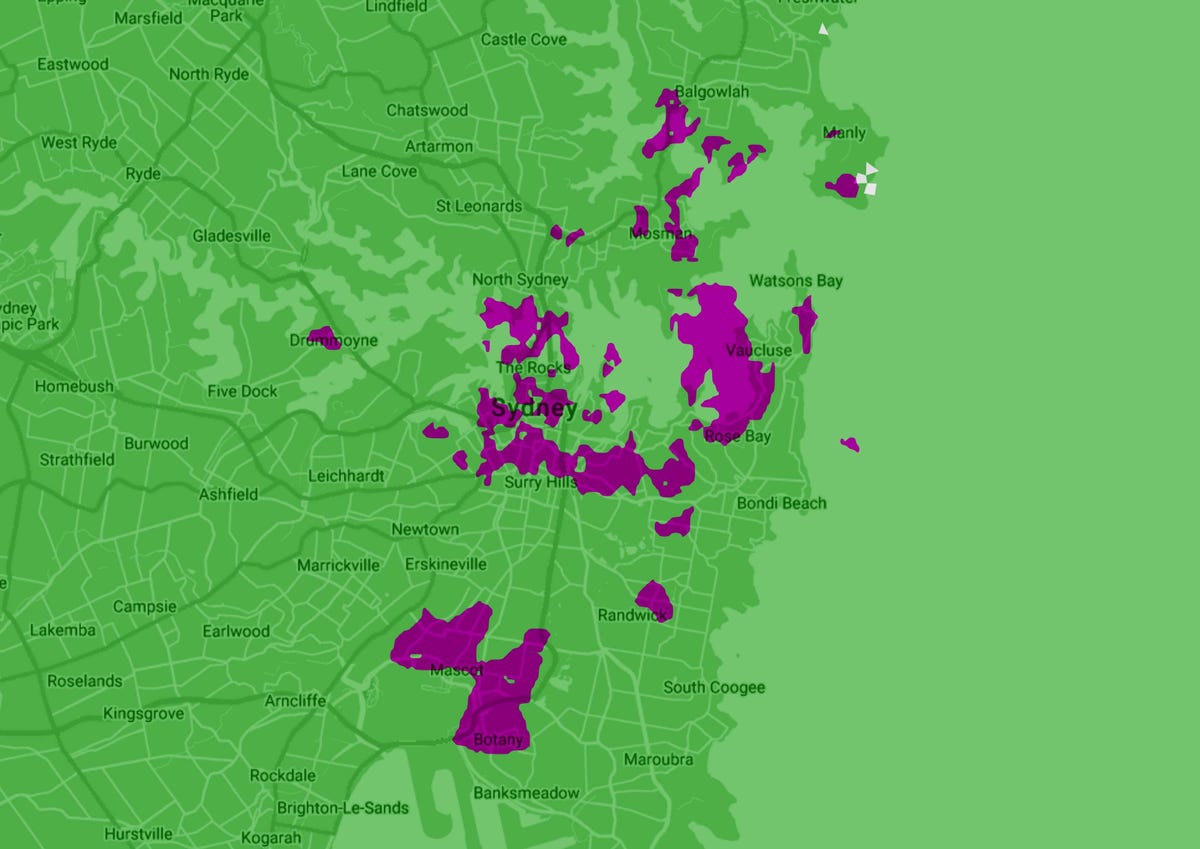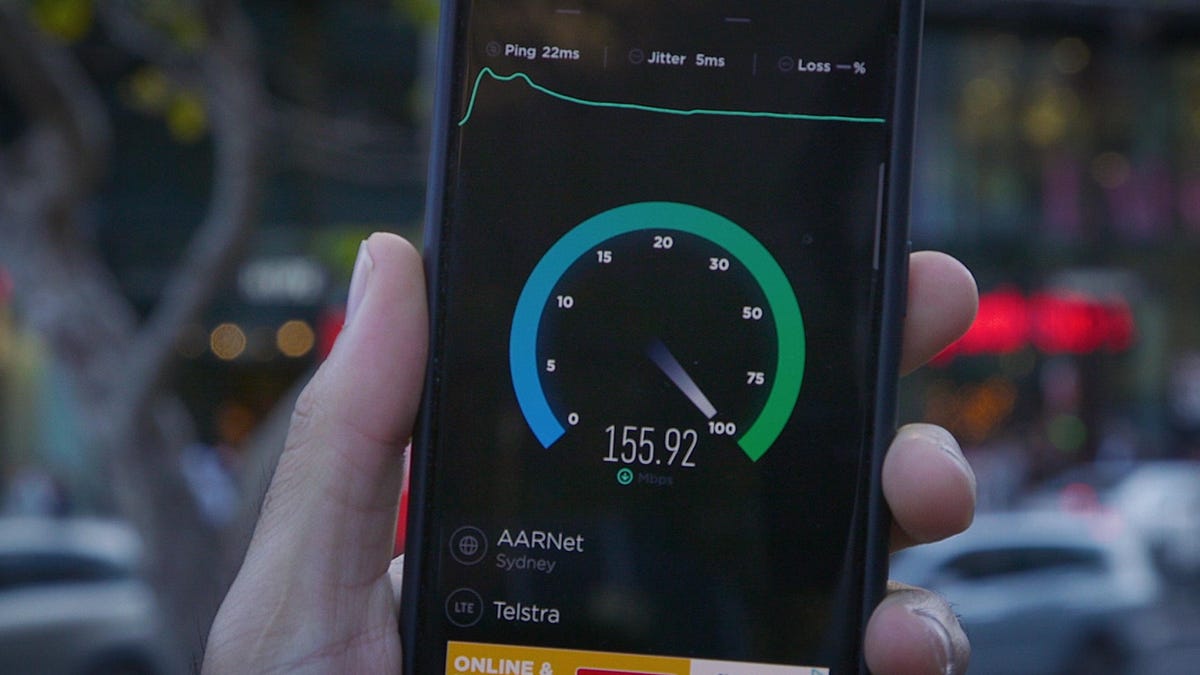I’m sitting on a park bench on a sunny Friday in Randwick, a Sydney suburb just a hop, skip and jump away from Bondi Beach. I’ve stopped to smell the roses like a retiree, except instead of feeding the birds breadsticks I’m perusing the Google Play store for a game. I feel like some chicken dinner. PUBG it is! I click download. I check Twitter. I answer an email. After 54 seconds, PUBG, a 2.04GB game, is ready to play.
This accelerated download speed, much faster than the 5 minutes, 57 seconds it takes to download the game via my office broadband, happens thanks to LG’s 5G-equipped V50 ThinQ. Is this the future? Almost.


Now playing:
Watch this:
5G phones you can buy right now
1:27
5G has been hailed as the next big tech revolution, powering everything from self-driving cars to smart farming equipment. The technology, which promises a faster, smarter and more responsive network, has begun its protracted launch throughout Australia. As with 5G in the UK, there’s only one carrier that offers working mobile 5G servers so far: Telstra. (Optus, a competing carrier, is also rolling out 5G, but in the form of home broadband connections.)
My sitting on a park bench in Randwick, four miles away from my office, isn’t an accident. I’ve come here because there are only a handful of suburbs in Sydney where 5G is accessible, and Randwick is one of them.
The stakes for 5G are particularly high in Australia, where we have world-class 4G and third-world broadband. Our state-run National Broadband Network has been an ongoing catastrophe for a decade, costing more than originally anticipated and delivering slower speeds than originally promised. It’s such a problem that there’s an argument that 5G could actually be a tenable replacement for broadband.
Technically speaking, we’re now in the 5G era. In the US, Sprint and Verizon already offer 5G phones like the Samsung Galaxy S10 5G. Also like Telstra, the coverage is limited — our Speedtest.net download speeds for AT&T went above 1.7Gbps, with coverage limited to small business zones — yet expanding. Here in Australia, both LG’s V50, Samsung’s S10 5G and the Oppo Reno 5G are tickets to the mobile internet of tomorrow. But the key word here is “tomorrow.”
Telstra stats
- 5G cities today: Adelaide, Perth, Sydney, Toowoomba, Launceston, Melbourne, Hobart, Gold Coast, Canberra, Brisbane
- 5G phones: LG V50 ThinQ, Samsung Galaxy S10 5G, Oppo Reno 5G
- Coverage area: Telstra says there will be a 2-kilometer (1.2-mile) coverage area in each capital city’s central business district by the end of June. Telstra expects its coverage area to increase “almost fivefold” and reach “at least” 35 cities by June 2020.


Telstra’s 5G coverage in Sydney as of the end of May.
Telstra


Here’s what coverage will look like by the end of June. Telstra says its coverage around the country will increase fivefold by June 2020.
Telstra
As of late May, there are a handful of areas in Sydney that are 5G-certified, according to Telstra. I tried three of them — the suburbs of Randwick (east), Mosman (north) and Broadway (central) — using both the LG V50 ThinQ and Oppo’s Reno 5G. Tests results delivered promising speed, but there are issues that need to be addressed.
First, let’s look at the good stuff. Using the Speedtest.net app, I was able to record nippy speeds of 500Mbps in both Mosman and Randwick. In Randwick, I got a 485Mbps download, 63Mbps upload, whereas Mosman’s network offered 489Mbps down, 64.3 up. For comparison, the average 4G speed in Australia is 37Mbps download and 8.2Mbps upload. So, on paper, Telstra’s 5G’s download speeds hit 13 times the national average and its upload speeds, seven times the average.
How does that translate to downloading actual files? Inconsistently. In Randwick I downloaded PUBG in 54 seconds using the LG V50. PUBG weighs in at 2.04GB, so that’s roughly a gigabyte per 27 seconds. The Oppo Reno 5G was slightly slower, taking 81 seconds. Wine Country, a movie starring Amy Poehler, downloaded from Netflix in 92 and 85 seconds on the V50 and Reno 5G, respectively.
For comparison, I connected the LG V50, which tended to have slightly faster download speeds, to my home broadband. I have a 100Mbps download plan, which is the best you can get in Australia. It took 5 minutes, 55 seconds to download PUBG and 110 seconds to download Wine Country.
We’re not in the promised land yet, though. We’re very much in the early days of 5G, meaning there are significant teething issues.
When it comes to 4G versus 5G, Netflix seems to be immune to 5G power. At Broadway, a region near Sydney’s central business district, my Optus 4G-connected iPhone XS Max downloaded Wine Country in 2 minutes and 10 seconds — 9 seconds faster than the Oppo Reno 5G (but slower than 5G on the LG V50). Even stranger, the LG V50 downloaded the movie in 66 seconds using Optus 4G at my home compared to 75 seconds at Broadway using Telstra 5G. PUBG, on the other hand, was faster across the board on 5G. I assumed Netflix’s Australian servers had yet to be optimized for 5G, but Netflix told me this was not the case.
Taking 4G out of the equation, 5G is inconsistent. The peak speeds are enticing, but there’s a huge chasm between them and the average. For instance, in Mosman, where the peak hit 489Mbps, walking one block south dropped download speeds to 289Mbps. In Randwick the results range was greater, topping at 485Mbps but also going as low as 92Mbps. (Uploads hovered between 40 and 65Mbps.)
Broadway fared far worse. There I ran five SpeedTest.net tests, and two hit over 100Mbps down (162, 155) while three, run about two blocks away, hovered around 50Mbps (55, 55, 49). Upload speeds ranged from 36Mbps in the first area and 56Mbps in the better-connected zone.


Testing 5G in Broadway.
Ian Knighton/CNET
There’s a silver lining here, though. PUBG, still 2.04GB, downloaded in 1 minute 58 seconds on the Oppo Reno in the Broadway area where I hit 150Mbps in Speedtest.net. That’s 37 seconds slower than in Randwick, but still dramatically faster than using broadband. It took 5 minutes and 57 seconds to download the game using the office Wi-Fi.
But of course, there’s the issue of how limited 5G areas are at the moment. You need to go out of your way to find yourself in a 5G zone. So really, it’s time to play the waiting game. Blazing fast internet is great — but it’s not worth investing too heavily in it until coverage is consistent and widespread. Right now, 5G is accessible, and it’s a thrill to see such breakneck download speeds, but coverage isn’t wide enough to make it truly useful.
5G in Australia
| Oppo Reno 5G (Randwick, Telstra) | LG V50 (Randwick, Telstra) | Oppo Reno 5G (Broadway, Telstra) | LG V50 (Broadway, Telstra) | LG V50 (4G, Optus) | LG V50 (NBN broadband) | |
| PUBG Mobile (2.04GB) | 81 seconds | 54 seconds | 118 seconds | 85 seconds | 3 minutes | 5 minutes, 55 seconds |
| Wine Country movie (143 minutes) | 85 seconds | 92 seconds | 2 minutes 15 seconds | 75 seconds | 66 seconds | 110 seconds |
| Peak Download | 485Mbps | 432Mbps | 162Mbps | 252Mbps | 61Mbps | 51.Mbps |
| Peak Upload | 63.3Mbps | 65.8Mbps | 56Mbps | 48.4Mbps | 10.6Mbps | 23.6Mbps |
The future will have speed bumps
Let’s fast-forward a year or two into the future. Let’s pretend 5G coverage is widespread. There are still two concerns.
The peak speeds, just below 500Mbps, are incredible. They’re over 10 times faster than Telstra’s (already excellent) average 4G speeds, and roughly five times faster than Australia’s broadband network. So yes, the speeds are futuristic — but they’re not what we’ve been promised.
Telstra’s ads and tech demos in recent weeks have shown 5G phones hitting 1.5 and even 2Gbps-plus speeds. Telstra has added the caveat that these speeds are faster than what we can expect out in the real world, but there is quite a gulf between 500Mbps and 2Gbps.
What’s more, the speeds promised or advertised by 5G industry figures in recent years are in the 20 to 30Gbps range. Just like widespread 5G connectivity seems a way off, so too do the promised peak speeds.
It feels petty to complain about speeds as fast as 489Mbps, regarding a network that’s not yet completely developed, simply because they’re not what we’ve been sold. But keep in mind that a 5G upgrade isn’t free, or even cheap. You’ll have to shell out a few hundred extra bucks for a 5G phone, and in the US both Sprint and Verizon only offer 5G on their pricier plans. In fairness to Telstra, it will offer 5G for free for the next 12 months, during which time infrastructure will be developed and rolled out. However, June 2020 will bring a $10 5G fee (AU$15). If you’re paying 5G prices, it’s fair to expect true 5G performance.
Wow! @OPPO Reno #5G reached 2+ Gbps running on @Telstra network. #5GisHere in
and the country gets the
for the fastest 5G speeds in a commercial network so far — but I’m confident the trophy will be moving across the globe over the next few months. https://t.co/S7Sidt8hdz pic.twitter.com/mAvimkV7Q7
— Ignacio Contreras (@IgnacioTechie) May 31, 2019
Testing 5G in Randwick, Sydney. That’s a funny lookin’ 1.5Gbps. pic.twitter.com/DoIUfUNlfz
— Daniel Van Boom (@dvanboom) June 14, 2019
That brings us to a more practical issue. As noted, Randwick was my first testing location. About 25 minutes in, after several speed tests, downloading PUBG and two movies from Netflix, I got an SMS. “You’ve used 50% of your 20GB data allowance,” Telstra warned me. Uh oh.
The SIM card I was using was loaned to me by Telstra for testing, but 20GB isn’t an unusually small amount. Telstra’s fattest data plan offers 150GB for $70 (AU$100) a month, but the average Australian has a 10GB data limit, according to a 2018 Finder study. Most plans in Australia give you between 10 and 50GB of data. In the US, “unlimited” data plans tend to include up to about 75GB, or 100GB for Sprint’s priciest plan, before internet speeds are throttled.
It will be impossible to burn through 50GB, let alone 150GB, just by using social media, answering emails and streaming YouTube on 4G. But with 5G speed comes incentive to, y’know, use 5G. When 5G speeds outpace home broadband by a significant margin, data will have to become cheaper for those blazing speeds to be convenient and truly useful.
Yes, 5G is here. It’s exciting. But just know the party only really starts once coverage is wider and data plans become bigger or, ideally, actually unlimited.
From Apple to Samsung: 5G phones available right now









